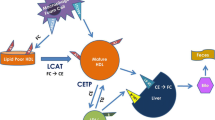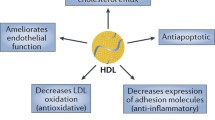Abstract
The ability of high-density lipoprotein (HDL) to promote cholesterol efflux is an important component of its ability to protect against cardiovascular disease. In addition, the anti-inflammatory properties of HDL are important as well. As part of the innate immune system, HDL appears to have evolved to increase inflammation in the presence of an acute phase response but to inhibit inflammation in the absence of an acute phase response. In a study of humans with coronary heart disease, it was found that the patients who had proinflammatory HDL prior to statin therapy (and half of them despite a profound decrease in plasma lipids following statin therapy) continued to have proinflammatory HDL. Anti-inflammatory HDL was effective in promoting cholesterol efflux whereas proinflammatory HDL was relatively weak in its ability to promote cholesterol efflux. Oxidative alterations of the main protein of HDL, apolipoprotein A-I, impaired its capacity to promote cholesterol efflux from monocyte macrophages. Therefore, HDL composition, structure, and function appear to be more crucial than HDL cholesterol concentrations in determining risk for cardiovascular disorders.
Similar content being viewed by others
References and Recommended Reading
Gordon T, Castelli WP, Hjortland MC, et al.: High density lipoprotein as a protective factor against coronary heart disease. Am J Med 1977, 62:707–714.
Ansell BJ, Navab M, Hama S, et al.: Inflammatory/antiinflammatory properties of high-density lipoprotein distinguish patients from control subjects better than high-density lipoprotein cholesterol levels and are favorably affected by simvastatin treatment. Circulation 2003, 108:2751–2756.
Navab M, Anantharamaiah GM, Reddy ST, et al.: The oxidation hypothesis of atherogenesis: the role of oxidized phospholipids and HDL. J Lipid Res 2004, 45:993–1007.
Downs JR, Clearfield M, Weis S, et al.: Primary prevention of acute coronary events with lovastatin in men and women with average cholesterol levels. JAMA 1998, 279:1615–1622.
Castelli WP, Garrison RJ, Wilson PW, et al.: Incidence of coronary heart disease and lipoprotein cholesterol levels. The Framingham Study. JAMA 1986, 256:2835–2838.
Ridker PM: On evolutionary biology, inflammation, infection, and the causes of atherosclerosis. Circulation 2002, 105:2–4.
Navab M, Imes SS, Hama SY, et al.: Monocyte transmigration induced by modification of low density lipoprotein in cocultures of human aortic wall cells is due to induction of monocyte chemotactic protein-1 synthesis and is abolished by high density lipoprotein. J Clin Invest 1991, 88:2039–2046.
Van Lenten BJ, Hama SY, deBeer FC, et al.: Anti-inflammatory HDL becomes pro-inflammatory during the acute phase response. J Clin Invest 1995, 96:2758–2767.
Gabay C, Kushner I: Acute-phase proteins and other systemic responses to inflammation. N Engl J Med 1999, 340:448–454.
Danesh J, Wheeler JG, Hirschfield GM, et al.: C-reactive protein and other circulating markers of inflammation in the prediction of coronary heart disease. N Engl J Med 2004, 350:1387–1397.
Navab M, Hama SY, Cooke CJ, et al.: Normal high density lipoprotein inhibits three steps in the formation of mildly oxidized low density lipoprotein: step 1. J Lipid Res 2000, 41:1481–1494.
Navab M, Hama SY, Anantharamaiah GM, et al.: Normal high density lipoprotein inhibits three steps in the formation of mildly oxidized low density lipoprotein: steps 2 and 3. J Lipid Res 2000, 41:1495–1508.
Navab M, Berliner JA, Subbanagounder G, et al.: HDL and the inflammatory response induced by LDL-derived oxidized phospholipids. Arterioscler Thromb Vasc Biol 2001, 21:481–488.
Van Lenten BJ, Wagner AC, Nayak DP, et al.: High-density lipoprotein loses its anti-inflammatory properties during acute influenza A infection. Circulation 2001, 103:2283–2288.
Van Lenten BJ, Wagner AC, Anantharamaiah GM, et al.: Influenza infection promotes macrophage traffic into arteries of mice that is prevented by D-4F, an apolipoprotein A-I mimetic peptide. Circulation 2002, 106:1127–1132.
Navab M, Hama SY, Hough GP, et al.: A cell-free assay for detecting HDL that is dysfunctional in preventing the formation of or inactivating oxidized phospholipids. J Lipid Res 2001, 42:1308–1317.
Shishehbor MH, Aviles RJ, Brennan ML, et al.: Association of nitrotyrosine levels with cardiovascular disease and modulation by statin therapy. JAMA 2003, 289:1675–1680.
Shishehbor MH, Brennan ML, Aviles RJ, et al.: Statins promote potent systemic antioxidant effects through specific inflammatory pathways. Circulation 2003, 108:426–431.
Zheng L, Nukuna B, Brennan ML, et al.: Apolipoprotein A-I is a selective target for myeloperoxidase-catalyzed oxidation and functional impairment in subjects with cardiovascular disease. J Clin Invest 2004, 114:529–541.
Zheng L, Settle M, Brubaker G, et al.: Localization of nitration and chlorination sites on apolipoprotein A-I catalyzed by myeloperoxidase in human atheroma and associated oxidative impairment in ABCA1-dependent cholesterol efflux from macrophages. J Biol Chem 2005, 280:38–47.
Pennathur S, Berg C, Shao B, et al.: Human atherosclerotic intima and blood of patients with established coronary artery disease contain high density lipoprotein damaged by reactive nitrogen species. J Biol Chem 2004, 279:42977–42983.
Bergt C, Pennathur S, Fu X, et al.: The myeloperoxidase product hypochlorous acid oxidizes HDL in the human artery wall and impairs ABCA1-dependent cholesterol transport. Proc Natl Acad Sci U S A 2004, 101:13032–13037.
Mackness B, Hunt R, Durrington PN, Mackness MI: Increased immunolocalization of paraoxonase, clusterin, and apolipoprotein A-I in the human artery wall with the progression of atherosclerosis. Arterioscler Thromb Vasc Biol 1997, 17:1233–1238.
Reddy ST, Hama S, Ng C, et al.: ATP-binding cassette transporter 1 participates in LDL oxidation by artery wall cells. Arterioscler Thromb Vasc Biol 2002, 22:1877–1883.
Fogelman AM: When good cholesterol goes bad. Nat Med 2004, 10:902–903.
Author information
Authors and Affiliations
Corresponding author
Rights and permissions
About this article
Cite this article
Navab, M., Yu, R., Gharavi, N. et al. High-density lipoprotein: Antioxidant and anti-inflammatory properties. Curr Atheroscler Rep 9, 244–248 (2007). https://doi.org/10.1007/s11883-007-0026-3
Published:
Issue Date:
DOI: https://doi.org/10.1007/s11883-007-0026-3




